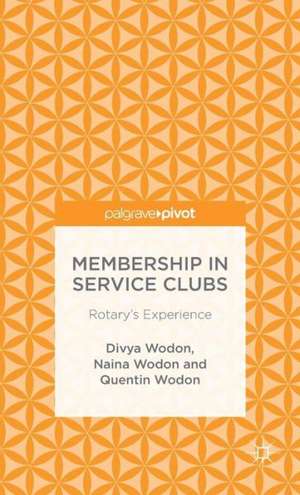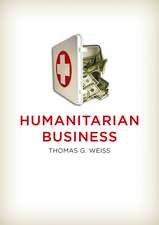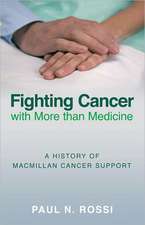Membership in Service Clubs: Rotary's Experience
Autor Divya Wodon, Naina Wodon, Quentin Wodonen Limba Engleză Hardback – 4 apr 2014
Preț: 386.39 lei
Nou
Puncte Express: 580
Preț estimativ în valută:
73.94€ • 76.28$ • 61.70£
73.94€ • 76.28$ • 61.70£
Carte tipărită la comandă
Livrare economică 27 martie-10 aprilie
Preluare comenzi: 021 569.72.76
Specificații
ISBN-13: 9781137444738
ISBN-10: 1137444738
Pagini: 167
Ilustrații: XII, 167 p.
Dimensiuni: 140 x 216 x 14 mm
Greutate: 0.38 kg
Ediția:2014
Editura: Palgrave Macmillan US
Colecția Palgrave Pivot
Locul publicării:New York, United States
ISBN-10: 1137444738
Pagini: 167
Ilustrații: XII, 167 p.
Dimensiuni: 140 x 216 x 14 mm
Greutate: 0.38 kg
Ediția:2014
Editura: Palgrave Macmillan US
Colecția Palgrave Pivot
Locul publicării:New York, United States
Cuprins
1. Introduction PART I: UNDERSTANDING THE CHALLENGE 2. What Is The Membership Challenge Faced By Clubs? 2.1. What Are Service Clubs And What Is Their History? 2.2. What Is Meant By The Decline In Civic Engagement In America? 2.3. What Factors Make Recruitment In Service Clubs More Difficult Today? 2.4. Summing Up PART II: GROWING THE MEMBERSHIP 3. Who Are The Rotarians, Why Did They Join, And How Satisfied Are They With Their 3.1. Membership Experience? 3.2. Who Are The Rotarians? 3.3. How Do Rotarians Perceive The Benefits Of Membership? 3.4. How Much Does It Cost To Be A Rotarian? 3.5. How Do Rotarians Assess The Performance Of Their Club? 3.6. Summing Up 4. How Can Districts Identify Geographic Areas For Growth? 4.1. How Can Membership Rates By Area Be Measured? 4.2. How Can Expected Membership Rates By Area Be Estimated? 4.3. How Can Potential Gains In Membership By Area Be Estimated? 4.4. How Can Targeted Areas For Growth Be Selected? 4.5. How Do Various Districts Compare Within A Zone? 4.6. Summing Up 5. How Can Clubs Innovate To Attract And Retain Members? 5.1. What Are North America's Targets And Rotary's Pilot Programs? 5.2. How Can Clubs Articulate Their Own Unique Value Proposition? 5.3. How Can Clubs Recruit New Members Effectively In Batches? 5.4. How Can Clubs Attract Younger Members? 5.5. How Can Retention Be Increased? 5.6. How Can Clubs And Districts Prepare Strategic Plans? 5.7. Summing Up PART III: ASSESSING AND CELEBRATING SERVICE 6. To What Extent Are Clubs And Districts Involved In Service? 6.1. How Much Service Do Rotarians Perform? 6.2. How Much Time Do Leadership Positions Take? 6.3. Are Rotarians Involved In Service Outside Of Rotary? 6.4. Are Survey Estimates Of Volunteer Time Reliable? 6.5. How Much Funding Do Clubs Allocate To Charitable Purposes? 6.6. Summing Up 7. What Types Of Service Projects Are Clubs Involved In And What Are Examples Of Successful Projects? 7.1. What Do Rotarians Do Exactly In Their Service? 7.2. How Can Tutoring Programs Help Children Learn In America? 7.3. How Can Malaria And Infant Mortality Be Reduced In Africa? 7.4. Summing Up PART IV: SERVING THE MEMBERSHIP 8. How Can Districts Organize Successful Conferences? Component I: Quantitative Analysis 8.1. How Much Time And Resources Do District Conferences Absorb? 8.2. How Are Conferences Evaluated And How Can We Do Better? 8.3. Who Attends District Conferences? 8.4. How Satisfied Are Rotarians With District Conferences? 8.5. What Do Rotarians Want At District Conferences? 8.6. Summing Up 9. How Can Districts Organize Successful Conferences? 9.1. Component II: Qualitative Analysis 9.2. What Additional Insights Do Qualitative Data Provide? 9.3. What Did Rotarians Enjoy The Most At The Conferences? 9.4. What Were The Areas Where Rotarians Suggested Improvements? 9.5. Summing Up 10. Conclusion Annexes Annex 1: District 7620 Membership Survey Questionnaire Annex 2: District 7620 Conference Evaluation Questionnaire Annex 3: Stories From District 7620 Rotarians
Recenzii
"This book should be required reading for members of service clubs around the world and for those interested in evaluating the contributions of volunteers. Very little research is publicly available on the impact of service clubs, the challenges they face and the opportunities they have. The book is based in part on surveys and interviews conducted for District 7620 (central Maryland and Washington, DC) but is also relevant for other districts. It considers seven main questions: What is the membership challenge faced by clubs?; Who are their members, and how satisfied are they with their club experience?; How can areas for growth be identified?; How can clubs innovate to attract and retain members?; How much service work do clubs engage in?; What types of work do they do, and what makes projects successful?; And finally, how can district events be more engaging? While the book is based on rigorous research, it is written in a very readable way so that service club members and those interested in their work can learn from the research and better succeed in their mission." - Peter Kyle, District Governor, Rotary District 7620
Notă biografică
Author Quentin Wodon: Quentin Wodon is an Adviser and Coordinator in the Education Global Practice at the World Bank.










